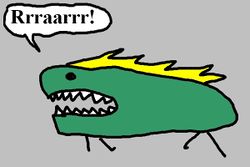Incertae sedis
| Seaside Cretin (uncommon) | |
|---|---|
The Uncommon Seaside Cretin: Terrifying animal of wild uncertainty. | |
| Scientific classification | |
| Kingdom | Animalia |
| Phylum | (unknown) |
| Class | (unknown) |
| Order | (unknown) |
| Family | (unknown) |
| Genus | Incertae |
| Species | sedis |
| Binomial name | |
| Incertae sedis | |
| Diversity | |
cyan 5%, orange 15%, green 40%, yellow 20%, blue 30% | |
| Habitat | Desert; Tundra; Inner cities; Rain forests |
| Conservation status | |
| (unknown) | |
| Conversation status | |
| Virtually non-existent | |
The uncommon Seaside Cretin (species Incertae sedis (TJ Sporker, 1937)) is a timid woodland creature which inhabits the frozen wastelands of the Arkansas Desert in great numbers.
Taxonomic classification (or lack thereof)[edit | edit source]
In the original Latin, Incertae sedis means "incertae sedis", which is hardly informative for those who do not understand Latin. However, translation into English yields "uncertain placement", which could mean one of any number of entirely unrelated things. A few science pundits have morbidly joked that the taxonomic classification (or lack thereof) of the uncommon seaside cretin is, therefore, ironically appropriate as it were.
Origins[edit | edit source]
The evolutionary origins of the seaside cretin remain completely inaccessible, buried under thousands of meters of solid rock. Its immediate ancestor, the Earth-dwelling subcutaneous cretin (Incertae neanderthalis) flourished in the Early Abiozoic (c. 3,700,000,000 years BCE), but went extinct last week. Today's ultramodern Seaside cretin has since evolved to spontaneously reject any form of evolutionary nonsense.
Discovery[edit | edit source]
The uncommon seaside cretin was first discovered by the Greek philosopher Hypocrites in 450 BCE. It was subsequently discovered by the non-Greek explorer Christopher Columbus in 1493, and finally by Thomas Juanito Sporker in 1937, who, incidentally, wasn't Greek either. Sporker, being of sound mind and debatable eyesight, accidentally tripped over many thousands of the elusive cretins in sequential order over a period of several days during an impromptu sojourn in deepest and darkest Australia. He then took some of the friendly creatures home with him for, what he alleged at the time, "completely nonsexual purposes".
Dr Sporker's first submitted manuscript about the boring details of his mundane discovery was soundly rejected by the National Enquirer as being much too sensational. It was only after a night of binge-drinking of the local tap water and sixty unproductive years in the local hospital that he had the nerve to e-mail an actual freeze-dried specimen (painfully extricated from one of his patent-pending Sporker Seaside Cretin Traps™) to the local branch of the Smithsonian Institution. Sporker officially gave the animal its well-known non-d'-plume ("Seaside Cretin"), loosely adapted from the original-language name that the first Australian convict settlers begrudgingly gave it in 1788.
Anatomy[edit | edit source]
The seaside cretin is unique in the mammalian world in possessing its own set of Black-and-Decker power tools. Its large supply of 17-inch-long fangs serve to tenderize the toughest steaks that the 99 Restaurant can dish out. Even though the seaside cretin is entirely herbivorous, it is more often than not colossally overweight from incessant feasting on healthy snack foods. Lacking any semblance of hair, fur, or even skin, seaside cretins are notoriously shy, and will often shamefully hide behind giant redwood trees in order to conceal their exposed microscopic genitalia from public and/or private scrutiny.
Intensive X-ray analysis of the seaside cretin reveals the inner-most secrets of its countless external organs. Being a unicellular animal, the seaside cretin is extremely allergic to even the most casual mention of the word "peanut" in its intermediate vicinity. The internal bones of its delicate and fragile body exceed the toughness of stainless steel, or even spider silk; and are capable of withstanding the irresistible forces of hurricane-strength wind tunnels.
Behavior in the wild[edit | edit source]
The seaside cretin uses its sleek and graceful form to quietly stalk its prey: namely, another seaside cretin. Two (2) of them will then take turns, on alternate weekends, to either lovingly groom one another with assorted hair-styling equipment, or viciously attack one another with oversized Q-Tips®. Seaside cretins also enjoy many strenuous activities such as nude hiking, nude sand-surfing, nude bathing, mindless vegetation, and extreme nudism.
In 1683, Canadian scientists secretly filmed a colony of seaside cretins independently forming their own parliamentary government, complete with congressional districts and an involuntary self-incarceration system. However, the entire colony was wiped out by a deadly plague of dandruff that very afternoon. The surviving cretins have since been adopted by various volunteer environmentalist rednecks from southern Antarctica.
Despite its common name, the uncommon seaside cretin has a dreadful fear of all known forms of water, especially ice IX. Even so, it is a world-class swimmer, perfectly capable of doing the dreaded breaststroke much faster than Mark Spitz during his best Olympic performances.
Life cycle[edit | edit source]
Seaside cretins are extremely gregarious, except during the mating season (January 1 to December 31 inclusive) when they all instinctively flee away from each other in abject terror. The average lifespan of the uncommon seaside cretin is approximately five months, but one born in captivity managed to survive up to 6 weeks before keeling over. The gestation period lasts for upwards of 15 years, after which it lays an already-broken egg and millions of squirming larvae. The adult form (which only superficially resembles a squirming larva) takes many thousands of hits to slay, even with BigGoron's sword; and yields only 20 experience points and 5 rupees per kill.
The seaside cretin is particularly vulnerable to clinical mediocrity after intense sexual activity, and will readily fall asleep in throes of agony if you look at it too hard.
Conservation status[edit | edit source]
Seaside cretins were declared an endangered species in 1979. Since then, all extermination efforts have failed miserably. As of 2025, the estimated worldwide population of seaside cretins stands at 2,718,000,000,000,000,000,000 (+/- 0.1), all of which are males and flaming homosexuals.


